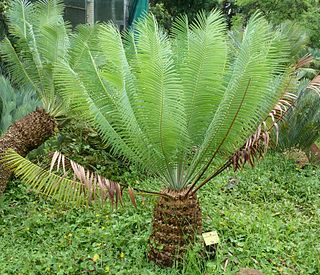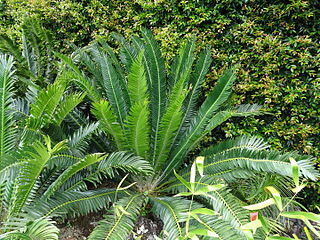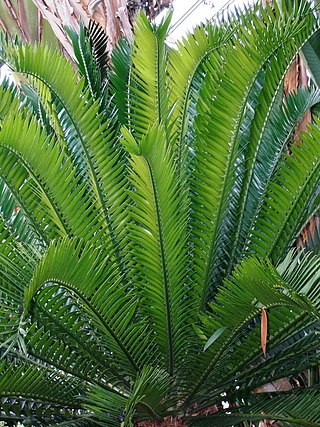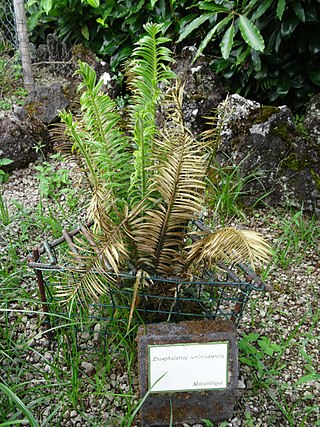
Encephalartos senticosus is a species of cycad in the family Zamiaceae native to the Lebombo Mountains of Mozambique, Eswatini (Swaziland), and the KwaZulu-Natal province of South Africa. Prior to its description in 1996, Encephalartos senticosus had been confused with the closely related and sympatric Encephalartos lebomboensis. Both species are commonly known as the Lebombo cycad.

Encephalartos turneri is a species of cycad that is native to Mozambique. The Encephalartos turneri was discovered by Ian Sutherland Turner in Nampula, Mozambique.

Encephalartos trispinosus is a species of cycad that is native to the Eastern Cape Province of South Africa.

Encephalartos pterogonus is a species of cycad that is native to Mount Mruwere and adjacent mountains in the Manica province of Mozambique.

Encephalartos paucidentatus is a species of cycad.

Encephalartos cycadifolius is a species of cycad that is native to the Winterberg mountains to the north of Bedford in the Eastern Cape province, South Africa. It is found at elevations from 1,200 to 1,800 meters.

Encephalartos barteri is a species of cycad that is native to Benin, Ghana, Nigeria, and Togo.

Encephalartos middelburgensis is a species of cycad that is native to Gauteng and Mpumalanga provinces of South Africa at elevations of 1,100–1,400 m (3,600–4,600 ft).

Encephalartos kisambo is a species of cycad in the family Zamiaceae. It is known as the Voi cycad.

Encephalartos inopinus is a species of cycad that is native to Limpopo Province, South Africa.

Encephalartos hirsutus is a species of cycad that is native to Limpopo Province of South Africa. It was recorded from three separate localities on south-east-facing quartzite cliffs in the Makuya Nature Reserve bordering the Kruger National Park at elevations ranging from 800–1,000 meters (2,600–3,300 ft) above sea level.

Encephalartos hildebrandtii is a species of cycad in the Zamiaceae family. It is native to Kenya and Tanzania at elevations from sea level to 600 metres (2,000 ft). The species is named for the German explorer Johann Maria Hildebrandt.

The Chimanimani cycad is a species of cycad that is endemic to the Chimanimani Mountains of eastern Zimbabwe. It is a threatened species which has been locally extirpated by cycad collectors.
Encephalartos poggei is a species of cycad in the family Zamiaceae. It is referred to by the common name Kananga cycad. It is native to Angola, the Democratic Republic of the Congo and Zaire.
Encephalartos schaijesii is a species of cycad endemic to the Democratic Republic of the Congo. It is only found near Kolwezi in Shaba Province, Democratic Republic of the Congo. It occurs in Miombo woodlands.

Encephalartos septentrionalis, the Nile cycad, is a species of cycad in South Sudan, northern Uganda, northern Democratic Republic of the Congo, and the interior of the Central African Republic.

Encephalartos bubalinus is a species of cycad in Kenya and Tanzania.
Encephalartos heenanii is a species of cycad in Southern Transvaal Province, South Africa.
Encephalartos relictus is a species of cycad in Eswatini.

Encephalartos umbeluziensis is a species of cycad from Africa.
















